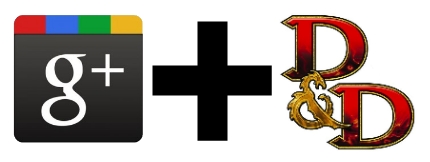Google Plus + Dungeons & Dragons: Post #3
Posted 9 years ago by Rob Lammle Games

Previously: Post #2 in our Google+ D&D Experiment
It’s been a very educational week in the land of Google+. We’ve learned quite a bit about running a campaign within the G+ infrastructure. Some good lessons, some bad. Let’s get to it!
The One Where Google Hates Me
Last time I told you about the use of custom hashtags to help separate your D&D posts from your animated .gifs of cats. They still work great…if you remember to use them. Sometimes in the heat of an adventure it’s very easy to forget to add your hashtag to a post, meaning it can easily get lost among all the other posts or if players only use the saved search to find the latest game posts. As I suggested before, if you could create an exclusive Circle, where the only posts that would appear in that Circle were meant for that Circle alone, then we’d be in business. Sadly, Google developers are not hanging on my every word yet, so that feature hasn’t made it into the latest round of updates.
So, I thought of another solution to this problem: Have everyone create a separate G+ profile only for D&D. I doubt you could use your character name – I’m sure the folks at Google would recognize “Rothar the Destroyer of Worlds and Lover of Puppies” as a fictitious name – but there are plenty of ways you could come up with a name that would pass inspection. This would allow you to create a campaign Circle and then every post would be game-related. You could even create multiple campaign Circles if you’re a hardcore player. Although if you have a friend that is playing in more than one campaign with you, his/her posts will show up in both campaign Circles, so it’s not a perfect solution, either. However, if you’re only playing one campaign at a time, or you play with completely separate groups of people, this would be a pretty good way to do things. But if you get caught by the Google Detectives for having a fake profile, leave my name out of it.
It’s All About the Story
My method for telling the story in a G+ campaign has been to have the DM start every thread. I usually start a new thread whenever we change locations, which means my descriptive text serves as a sort of anchor. If you’re familiar at all with writing movie scripts, it’s like putting the scene indicator (SCENE VI: Ext – Daytime) at the top of a scene. Under that, the players post about what they’re doing, including attacking an enemy or attempting to pick the lock on a door. This allows them to maintain a constant context of where they are, what they’re doing, and it’s easy for them to scroll back through previous posts to see what’s in the room that might be useful. This is a great way to play, but, as I’ll point out later, is not without its flaws.
As you can see in the screen shot below, there are 21 comments on this post, so quite a bit happened in this room (We had our first encounter! And no one died! Well, except for a zombie…) before I posted a new thread after a player decided to go through Door #3.
Read More